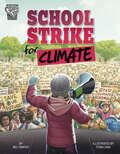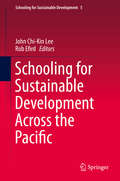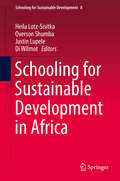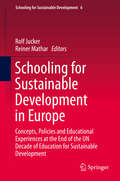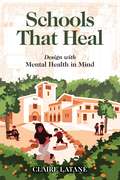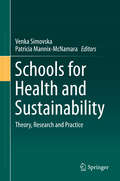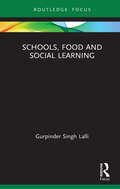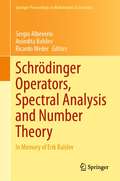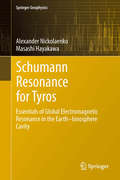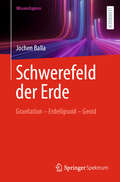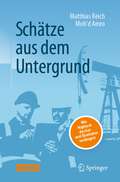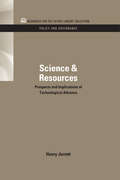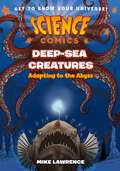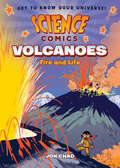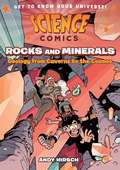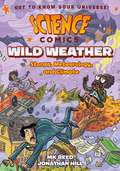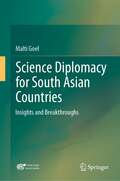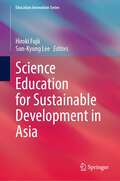- Table View
- List View
School Strike for Climate (Movements and Resistance)
by Nel YomtovIn August 2018, a teenager named Greta Thunberg missed school to sit outside the Swedish parliament with a sign that read School Strike for Climate. She was demanding that government leaders take stronger action against climate change due to global warming. At first, Greta sat alone. But her message spread. Other students joined her in the movement that became known as Fridays for Future. By September 2019, millions of activists from around the world marched in protests to protect the future of the planet.
Schooling for Sustainable Development Across the Pacific
by John Chi-Kin Lee Rob EfirdEnvironmental education (EE) and education for sustainable development (ESD) are asserting their growing role in curricula around the world, yet how deeply embedded are they in the learning systems of the Pacific nations? Building on an earlier analysis in China and Taiwan, this volume expands its purview to examine the quality and extent of environmental and sustainable development education in a number of countries in the Asia-Pacific region, including China itself, Taiwan, South Korea, Japan and Indonesia As well as offering detailed national analyses provided by Asian-Pacific academics and professionals, this work includes examples in the US and Canada and an introduction that assesses the contrasting challenges and positive commonalities among diverse education systems. The chapters reflect leading-edge practice, innovation, and depth of experience and at the same time as detailing locally relevant and culturally appropriate strategies they also provide clear models and strategies for expanding the application and influence of education for sustainable development elsewhere. In doing so, they mirror the global nature of environmental issues as well as the local nature of the solutions.
Schooling for Sustainable Development in Africa
by Heila Lotz-Sisitka Overson Shumba Justin Lupele Di WilmotThis book considers the scope and dynamics of Education for Sustainable Development (ESD) and learning in schools in Africa. It explores the conditions and processes that support such learning, and examines how ESD in schooling can improve the quality and relevance of education. The quality of education has been defined internationally as a key concern for educational institutions around the world, including schools in Africa. The models of quality are often limited to performance-based approaches and/or inclusive approaches. The contributions in this book show that there is more to a discussion on educational quality in Africa than performance success and/or inclusion. The chapters explain how ESD brings a new relevance to education in Africa, and at the same time, sounds the beginning of a new concept of quality education. The volume presents a collection of experiences in creating and supporting quality learning processes through a variety of ESD practices.
Schooling for Sustainable Development in Europe
by Rolf Jucker Reiner MatharThis book examines the implementation of Education for Sustainable Development (ESD) programs in schools across Europe. It describes and analyzes how individual countries and the region as a whole have established teaching and learning methods to help students develop the competencies needed to be part of a sustainable society. Featuring chapters written by experts throughout Europe, the book first provides a general overview of ESD in various contexts, including the state-of-the-art of ESD theory and conceptual development; political and social analysis; the various concepts of ESD competencies; and teacher training. Next, the book details how ESD has been implemented in different European countries and regions, including: Sweden, Italy, Germany, Austria, Switzerland, Catalonia, Hungary, Finland, Norway, Denmark, Flanders, France, Cyprus, UK and the Netherlands. In recognition of education as a motor of change, the United Nations General Assembly declared a Decade of Education for Sustainable Development (2005-2014), calling for the integration of sustainable development into all aspects of education and learning. Inside this book, readers will find details on what has been done, as well as assessments of what more could be done, across Europe. It will help readers gain valuable insights into how to help students develop the knowledge, skills and values needed to shape a sustainable future.
Schools That Heal: Design with Mental Health in Mind
by Claire LataneWhat would a school look like if it was designed with mental health in mind? Too many public schools look and feel like prisons, designed out of fear of vandalism and truancy. But we know that nurturing environments are better for learning. Access to nature, big classroom windows, and open campuses consistently reduce stress, anxiety, disorderly conduct, and crime, and improve academic performance. Backed by decades of research, Schools That Heal showcases clear and compelling ways—from furniture to classroom improvements to whole campus renovations—to make supportive learning environments for our children and teenagers. With invaluable advice for school administrators, public health experts, teachers, and parents Schools That Heal is a call to action and a practical resource to create nurturing and inspiring schools for all children.
Schools for Health and Sustainability
by Venka Simovska Patricia Mannix McnamaraSchools are unique places. They pay a central role in the formation of young people. The importance of how young people are educated and how they are encouraged to live and learn cannot be underestimated. This book advocates for the fostering of agency not only amongst school personnel but also amongst younger generations for health and sustainability. It provides the reader with a new lens with which to discover health promoting schools and education for sustainable development. It invites the reader to look more deeply into both and to accompany the authors on a journey of discovery of the real potential for each to enhance the practice of schooling.
Schools, Food and Social Learning
by Gurpinder Singh LalliThis book explores the potential of school dining halls as spaces of social learning through interactions between students and teachers. Schools, Food and Social Learning highlights the neglect of school dining halls in sociological research and the fact that so much can be gained from fostering interpersonal relations with other students and the school staff over meals. The book focuses primarily on social and life skills that students develop during lunch-hour meetings, modelling behaviors while eating and conversing in the school space known as the ‘restaurant’. With case studies based in the UK, the book takes a social constructivist approach to dealing with the tensions and challenges between the aims of the school – creating an eating space that promotes social values and encourages the development of social skills, and the activities of teachers and catering assistants of managing and providing food for many students daily. The book carries snippets of interviews with children, dining hall attendants, teachers, parents and the school leadership team, offering a new way of thinking about social learning for both scholars and students of Social Anthropology, Sociology, Social Policy, Food Policy, Education Studies and Childhood Studies.
Schritt für Schritt ins Nachhaltigkeitsmanagement: Einstieg für Sozialwirtschaft, Freie Wohlfahrtspflege und Kirche
by Stefanie Oeben Inci WiedenhöferDieses Buch bietet eine Schritt-für-Schritt-Anleitung für Sozialwirtschaft, Freie Wohlfahrtspflege und Kirche, um Nachhaltigkeitsthemen und damit Zukunftsthemen zu identifizieren und implementieren. Denn der Einstieg in die Nachhaltigkeitsberichterstattung ist nicht nur die Entscheidung für eine transparente, sich ehrlich machende Organisation, sondern auch die Entscheidung dafür, strategische Zukunftsthemen bewusst anzugehen. Darüber hinaus spielen Nachhaltigkeitskriterien mittlerweile eine wichtige Rolle bei der Vergabe von Finanzmitteln und öffentlichen Aufträgen, so dass sich der Einstieg in die Nachhaltigkeitsberichterstattung auch direkt auf das operative Geschäft auswirkt. Doch womit zuerst beginnen? Die Autorinnen zeigen auf, wie unter Einbeziehung der relevanten Anspruchsgruppen ökonomische, ökologische und soziale Ziele identifiziert und strukturiert bearbeitet werden können. Mit praktischen Tipps und Themenlisten, die auf die speziellen Bedürfnisse von Sozialwirtschaft,Freie Wohlfahrtspflege und Kirche zugeschnitten sind, lotsen die Autorinnen durch die einzelnen Stufen, die auf dem Weg zu einer systematischen und fundierten Berichterstattung nach dem anerkannten Standard des Deutschen Nachhaltigkeitskodexes (DNK) zu nehmen sind.
Schrödinger Operators, Spectral Analysis and Number Theory: In Memory of Erik Balslev (Springer Proceedings in Mathematics & Statistics #348)
by Sergio Albeverio Ricardo Weder Anindita BalslevThis book gives its readers a unique opportunity to get acquainted with new aspects of the fruitful interactions between Analysis, Geometry, Quantum Mechanics and Number Theory. The present book contains a number of contributions by specialists in these areas as an homage to the memory of the mathematician Erik Balslev and, at the same time, advancing a fascinating interdisciplinary area still full of potential. Erik Balslev has made original and important contributions to several areas of Mathematics and its applications. He belongs to the founders of complex scaling, one of the most important methods in the mathematical and physical study of eigenvalues and resonances of Schrödinger operators, which has been very essential in advancing the solution of fundamental problems in Quantum Mechanics and related areas. He was also a pioneer in making available and developing spectral methods in the study of important problems in Analytic Number Theory.
Schumann Resonance for Tyros
by Masashi Hayakawa Alexander NickolaenkoSchumann resonance has been studied for more than half a century. The field became popular among researchers of the terrestrial environment using natural sources of electromagnetic radiation--lightning strokes, primarily--and now many Schumann observatories have been established around the world. A huge number of publications can be found in the literature, the most recent collection of which was presented in a special Schumann resonance section of the journal Radio Science in 2007. The massive publications, however, impede finding information about how to organize measurements and start observations of global electromagnetic resonance. Relevant information is scattered throughout many publications, which are not always available. The goal of this book is to collect all necessary data in a single edition in order to describe the demands of the necessary equipment and the field-site as well as the impact of industrial and natural interference, and to demonstrate typical results and obstacles often met in measurements. The authors not only provide representative results but also describe unusual radio signals in the extremely low-frequency (ELF) band and discuss signals in the adjacent frequency ranges.
Schwerefeld der Erde: Gravitation - Erdellipsoid - Geoid
by Jochen BallaFür die Fallbeschleunigung ist der Wert von 9.81 m/s² allgemein bekannt. Wer über diesen Durchschnittswert hinaus die Unterschiede im Schwerefeld der Erde verstehen möchte – welches im Bereich von 9.78 m/s² bis 9.83 m/s² variiert –, muss sich mit der Gravitation des ellipsoidischen Erdkörpers auseinandersetzen. Genau das ist das Thema dieses Buchs. Es erklärt die notwendigen Begriffe und Konzepte, um über das einfache Modell einer kugelförmigen Erde hinauszugehen. Dabei werden auch die physikalischen und mathematischen Grundlagen vermittelt, sodass die Lektüre ohne spezielle Vorkenntnisse aus der Potenzialtheorie möglich ist. Das Buch richtet sich an Studierende der Physik, Geophysik, Geodäsie, Ozeanographie und verwandter Fachgebiete, die eine präzise Kenntnis des Erdschwerefelds benötigen. Sein Inhalt in Schlagworten: • Physikalische Grundlagen • Gravitationsgesetz und Potenzial • Gravitation und Schwerefeld des ellipsoidischen Erdkörpers • Niveauellipsoid und Normalschwere • Gezeiten • Geoid, Quasigeoid und Höhen. Die Produktfamilie WissensExpress bietet Ihnen Lehr- und Lernbücher in kompakter Form. Die Bücher liefern schnell und verständlich fundiertes Wissen.
Schätze aus dem Untergrund: Wie Hightech das Gas- und Ölzeitalter verlängert
by Matthias Reich Moh’d AmroDer ideale Einstieg in die Welt der Fördertechnik flüssiger RohstoffeDie Erdkruste enthält viele fließfähige Schätze, ohne die unsere moderne Gesellschaft nicht funktioniert. Hierzu zählen Erdöl und Erdgas, aber auch in zunehmendem Maße umweltfreundliches heißes Wasser, das wir in Form von geothermischer Energie nutzen können. Entgegen der Vorstellung vieler Menschen findet man diese Fluide allerdings nicht in unterirdischen Höhlen, sondern in den mikroskopisch kleinen Poren des Gesteins in mehreren Kilometern Tiefe. Dort herrschen Temperaturen wie im Pizzabackofen und Drücke wie unter den Reifen landender Großflugzeuge. Der erste Band „Auf Jagd im Untergrund“ (Springer, 2022) erklärt, wie die Tiefbohrungen angelegt werden, mit denen man solche Lagerstätten zunächst einmal erreicht. Der vorliegende zweite Band erklärt in anschaulicher Weise, wie diese Lagerstätten im Detail aussehen und welche unterschiedlichen Methoden es gibt, die wertvollen Poreninhalte sicher und ohne Schädigung der Umwelt zur Oberfläche zu bekommen. Das Buch richtet sich an alle technisch interessierten Laien, insbesondere an alle „Nicht Techniker“, die mit der großen Welt der Energieversorgung und Rohstoffgewinnung zu tun haben oder zu tun haben wollen.
Science & Life Issues: Ecology and Evolution
by University of California at Berkeley Lawrence Hall of ScienceScience and Life Issues, or SALI, uses several kinds of activities to teach science. For example, you will design and conduct an experiment to investigate human responses. You will explore a model of how species compete for food. And you will play the roles of scientists learning about the causes of infectious disease. A combination of experiments, readings, models, debates, role plays, and projects will help you uncover the nature of science and the relevance of science to your interests.
Science & Resources: Prospects and Implications of Technological Advance (RFF Policy and Governance Set)
by Henry JarrettFirst Published in 2011. Routledge is an imprint of Taylor & Francis, an informa company.
Science Comics: Adapting to the Abyss (Science Comics)
by Mike LawrenceTake the plunge with Science Comics: Deep-Sea Creatures! Science Comics is a popular STEM graphic novel series with over a million copies in print!Every volume of Science Comics offers a complete introduction to a particular topic—dinosaurs, the solar system, volcanoes, bats, robots, and more! In this volume, you'll see real-life sea creatures like giant isopods, colossal squids, blood-sucking lampreys, and horrific anglerfish. Unravel the mysteries of how these creatures evolved to survive where there is no light, hardly any food, and water pressure so intense it would squash you like a sea slug! Turn the page and prepare to go deep!
Science Comics: Fire and Life (Science Comics)
by Jon ChadGet ready to explore the depths of the ocean, the farthest reaches of space, and everything in between! Volcanic eruptions, vampire bats, feathered velociraptors, and more await you in SCIENCE COMICS. In a not-so-distant future our world is as cold as a frozen burrito. But can humanity save itself by harnessing a power that dwells inside the Earth? Explode into the world of geology in Volcanoes: Fire and Life! A lot of magic happens under the Earth's crust. Thanks to magma vents, shifting continental plates, and volcanic eruptions, we know that our planet is alive and in motion. Alongside Aurora, a young explorer, you'll learn that volcanoes are just one of the massively powerful forces at work on our planet. From catastrophic destruction to the creation of new land masses, volcanoes have made their mark on our amazing Earth.
Science Comics: Geology from Caverns to the Cosmos (Science Comics #1)
by Andy HirschLeave no stone unturned with Andy Hirsch's Science Comics: Rocks and Minerals, the latest volume in First Second’s action-packed nonfiction graphic novel series for middle-grade readers!In this volume, join a crystal-crazy fanboy and a famous rock hunter on a geological journey that will take them to the summit of a volcano, deep within the earth, and even into outer space! They'll learn about the unstoppable forces that shape our planet and they might even pick up a gemstone or meteorite along the way.Every volume of Science Comics offers a complete introduction to a particular topic—dinosaurs, the solar system, volcanoes, bats, robots, and more! Whether you're a fourth grader doing a natural science unit at school or a thirty-year-old with a secret passion for airplanes, these graphic novels are for you!
Science Comics: Storms, Meteorology, and Climate (Science Comics)
by MK ReedFurious floods, looming landslides, terrifying tornadoes, ferocious forest fires! Is Mother Nature trying to tell us something? As “snowpocalypse” descends once again, one temperamental weatherman is determined to set the record straight on the myths and misconceptions surrounding the elements. What is the difference between weather and climate? How do weather satellites predict the future? Can someone outrun a tornado? Does the rotation of the Earth affect wind currents? And does meteorology have anything to do with meteors? Stormin’ Norman Weatherby is gearing up to answer all your wildest questions! Get ready to explore the depths of the ocean, the farthest reaches of space, and everything in between! These gorgeously illustrated graphic novels offer wildly entertaining views of their subjects. Whether you're a fourth grader doing a natural science unit at school or a thirty-year-old with a secret passion for airplanes, Science Comics is for you!
Science Communication in a Crisis: An Insider's Guide
by Christopher ReddyScience Communication in a Crisis: An Insider’s Guide identifies the principal challenges that scientists face when communicating with different stakeholder groups and offers advice on how to navigate the maze of competing interests and deliver actionable science when the clock is ticking. If a scientist’s goal is to deliver content and expertise to the people who need it, then other stakeholder groups—the media, the government, industry—need to be considered as partners to collaborate with in order to solve problems. Written by established scientist Christopher Reddy, who has been on the front lines of several environmental crisis events, the book highlights ten specific challenges and reflects on mistakes made and lessons learned. Reddy’s aim is not to teach scientists how to ace an interview or craft a soundbite, rather, through exploring several high-profile case studies, including the North Cape oil spill, Deepwater Horizon, and the 2021 Sri Lanka shipping disaster, he presents a clear pathway to effective and collaborative communication. This book will be a great resource for junior and established scientists who want to make an impact, as well as students in courses such as environmental and science communication.
Science Diplomacy for South Asian Countries: Insights and Breakthroughs
by Malti GoelThis book provides a science diplomacy outlook as a new governance tool in international cooperation. It elaborates on India's current S&T collaboration with Afghanistan, Bangladesh, Bhutan, Maldives, Myanmar, Nepal, Pakistan, Sri Lanka, and science policy and science diplomacy in India. The book introduces concepts and contours of science diplomacy with international examples. It presents insights into international governance models, mega-science projects, and science diplomacy's role in addressing global climate change and sustainable development challenges. The book is a valuable reference to spark breakthroughs in India’s science diplomacy with its neighbouring countries for scientists, diplomats, policymakers, government, and non-government institutions interested in science and diplomacy.
Science Education for Sustainable Development in Asia (Education Innovation Series)
by Hiroki Fujii Sun-Kyung LeeThis book presents an Asian perspective on transformative science education in the context of the United Nations' Sustainable Development Goals (SDGs). The chapters are written by contributors who practiced science education for sustainability in a research project entitled “Teacher Education for ESD in the Asia-Pacific Region” from 2017 to 2019, supported by the Japan Society for the Promotion of Science, and the Japanese National Commission for UNESCO. The book showcases the contributors’ innovations in science education for sustainability, presenting case studies of science teaching and learning, science curriculum and assessment, science education in collaboration with local communities, and science teacher education. Embodying Asian sustainability education paradigms, policies, and practices, these case studies depict the diversity and uniqueness of natural, social, and cultural contexts in Asia, while demonstrating their commonalities. Through examining these case studies, this book aims to provide examples for praxis, and prospects, for new science classes, curricula, and teacher education in implementing education for sustainable development.
Science Encyclopedia
by Ian Graham Barbara Taylor John Farndon Chris OxladeThis freshly updated book will introduce you to the whole field of science, from physics, chemistry, biology, information technology, Earth sciences and astronomy. New fields such as genetic engineering nanotechnology, telecommunications and the preservation of planet Earth.
Science Fusion Grade 6 Hudson County
by Donna M. Ogle Marjorie Frank Michael R. Heithaus Michael A. DispezioMany people think of science as simply a collection of facts. Science is the systematic study of natural events and conditions. Scientific subjects can be anything in the living or nonliving world. In general, all scientific subjects can be broken down into three areas--life science, Earth science, and physical science. Life science, or biology, is the study of living things. Life scientists may study anything from how plants produce food to how animals interact in the wild. Earth science, or geology, is the study of the surface and interior of Earth. An Earth scientist may study how rocks form or what past events produced the volcano you see in the photo. Physical science includes the subjects of physics and chemistry. Physicists and chemists study nonliving matter and energy.
Science Level Five (Second Edition)
by The Editors at the ACSI/Purposeful Design PublicationsThis Science book presents various important topics under the units : Life Science:Cycles,Physical Science: Transformations,Earth and Space science:Predictability and Human body: Balance.
Science Level Six (Second Edition)
by The Editors at the ACSI/Purposeful Design PublicationsThis Science book presents various important topics under the units : Life Science:Diversity,Physical Science: Structure,Earth and Space science:Patterns and Human body: Decisions.
